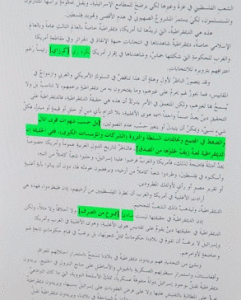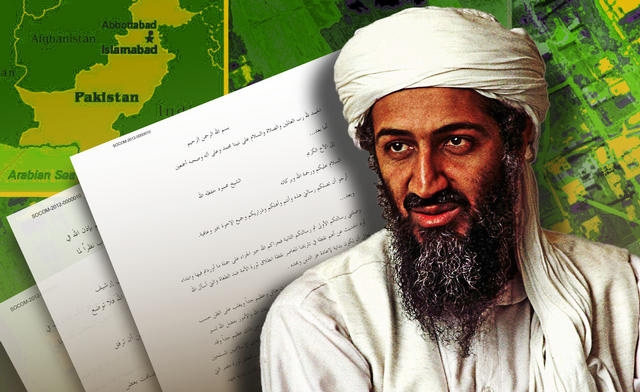After the killing of al Qaeda leader Osama bin Laden in Pakistan in May 2011, the US government announced that they had obtained a “treasure trove” of documents that would fill a “small college library”–estimated to be in the hundreds of thousands to one million documents. The importance of these documents was displayed by initial government statements that 400 threats had been identified within the first week of viewing the documents. Top al Qaeda experts believe that the documents show who was connected to al Qaeda and what direction the organization would take after the death of bin Laden, in addition to other information. The number of documents so far released, however, remains at 17, which were published two years ago in May 2012.
 Top al Qaeda experts, such as Long War Journal Senior Editor, Tom Joscelyn, 35-year terrorism scholar and former Corporate Chair in Counterterrorism and Counterinsurgency at the RAND Corporation and former Director of RAND’s Washington, D.C. Office, Professor Bruce Hoffman, and adjunct assistant professor in Georgetown University’s security studies program, Daveed Gartenstein-Ross think that there is no good reason the documents have not been released, and that the interpretation based on the official government line and the released documents is wrong.
Top al Qaeda experts, such as Long War Journal Senior Editor, Tom Joscelyn, 35-year terrorism scholar and former Corporate Chair in Counterterrorism and Counterinsurgency at the RAND Corporation and former Director of RAND’s Washington, D.C. Office, Professor Bruce Hoffman, and adjunct assistant professor in Georgetown University’s security studies program, Daveed Gartenstein-Ross think that there is no good reason the documents have not been released, and that the interpretation based on the official government line and the released documents is wrong.
“There’s a lot we can’t see.. and the stuff that we do see totally contradicts that paradigm,” said Joscelyn at a recent conference on terrorism. After bin Laden was killed, Joscelyn noted, referring to what the Obama administration had originally said about the extent of the archive found in bin Laden’s lair, Tom Donilon, a former Obama Administration National Security Advisor who was replaced by UN Ambassador Susan Rice in a White House shakeup last year, was one of the first officials to discuss bin Laden’s files. One week after the raid, Donilon described the files found in bin Laden’s residence as “the largest cache of intelligence derived from the scene of any single terrorist.” Donilon, citing the CIA, said the files would fill a “small college library.”
“The number I’ve had quoted to me from officials,” said Joscelyn, “is over a million documents and files. That’s certainly in the hundreds of thousands. Now are all those equally important? No. But a lot of them are.”
To date, only 17 documents and some videos have been released to the public.
“This is not transparency,” said Joscelyn. “I don’t care if this is a republican administration or a democratic administration… And I think a lot of our debate about how al Qaeda is structured, how if functions, how it’s organized.–I think the answers to a lot of those questions can be found in those documents. And I think there’s no good reason for a lot of those documents to be kept from the public.”
Georgetown University’s Gartenstein-Ross agreed with Jocelyn’s assessment of the documents, and commented that America was not doing all it could to use the documents to understand the al Qaeda terrorist threat.
“We should hasten the declassification of these documents in order to better harness the talents of open-source researchers,” said Gartenstein-Ross. “A lot of these areas where we can’t actually see the organization, open source researchers would understand much, much more if they had access to these documents. And, in my view, the vast majority of these–maybe 90 percent or more–could be released with no harm to national security, no harm to US national interests in any way.
“And I think open source research is very important. It informs the public, it can inform policy makers,” continued Gartenstein-Ross. “We should be getting the most out of this sphere. As long as these documents remain classified… we’re not going to be making the most of open source researchers.”
Professor Bruce Hoffman also agreed. “I couldn’t agree more. I think its shameful that only 17 documents out of literally thousands [have been released]. And anybody who does any kind of historical research knows that you cannot make any kind of judgments on anything based on a handful of highly selected documents. Why I also think it’s absolutely imperative that they should be opened up is the conflicting things we’ve been told about them.
Hoffman commented also on the contradictory nature of the US governments characterization of the documents.
“In May 2011 we were told that these documents incontrovertibly proved that bin Laden was a mastermind,” said Hoffman, “that he was far more involved in running al Qaeda operations than anyone assumed, that he was meeting financiers, that he had connections with affiliates and associates, and even the 17 documents that have been released are highly ambiguous, because you can find, actually, validation for all those points. But then, inexplicably, exactly a year later, in May 2012 we’re told that it says completely the opposite: that bin Laden wasn’t involved, that he was irrelevant, that al Qaeda never really existed as an organization. So which one is it?
“Now, admittedly, some of them, of course, are highly sensitive, for various intelligence reasons, but its hard to believe that we have not taken advantage of this opportunity to establish a baseline understanding of what al Qaeda was like in the last, final days of bin Laden’s reign, and in turn, how that would effect the current organization and direction of al Qaeda.
“This is completely lost,” concluded Hoffman, “and its completely inexplicable as well.”
As to the reason why the document had not been released, Joscelyn stated, “I think there are a lot of bad reasons they haven’t been released. I can’t think of any good ones. The bottom line…is we know the minimalist interpretation of what these documents say is wrong. Here’s how we know it’s wrong: Because James Clapper, DNI, got in front of Congress and said the immediate exploitation of these documents led to 400 individual threats being tracked down by the US intelligence community and its partners. Now think about that. That’s just the immediate threat stream that the US intelligence community was able to cull out of these documents. And there were more than 400 of them. And I’ve been told that’s actually more than 400 individual documents you’re talking about there in the threat stream.
Joscelyn also commented on the contradictory nature of the Obama administration’s characterization of the bin Laden documents. “Now that story–what Clapper said–is the precise opposite of the story that came out with the 17 documents that the administration released. The 17 documents came out not just as documents, but they came out with a narrative, and the narrative said that he was isolated or sidelined in Abad Abad. He was a lion in winter. None of that was true. We have Clapper saying to you that we have 400 immediate threats being culled out of these documents right away.
“You should want to see this incredible archive that has been captured,” concluded Joscelyn.
By Day Blakely Donaldson

